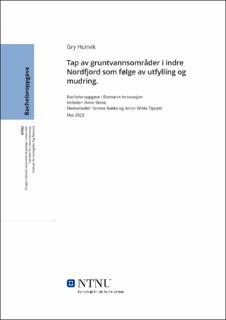| dc.contributor.advisor | Stene, Anne | |
| dc.contributor.advisor | Bakke, Snorre | |
| dc.contributor.advisor | Tippett, Arron Wilde | |
| dc.contributor.author | Hunvik, Gry | |
| dc.date.accessioned | 2023-06-24T17:20:01Z | |
| dc.date.available | 2023-06-24T17:20:01Z | |
| dc.date.issued | 2023 | |
| dc.identifier | no.ntnu:inspera:146720542:149498217 | |
| dc.identifier.uri | https://hdl.handle.net/11250/3073065 | |
| dc.description.abstract | I historisk sammenheng har elvedaler innerst i fjordarmer vært viktige bosetningsområder, og dannet grunnlaget for mange av de største tettstedene i Norge i dag. Dette har ført til behov for infrastruktur og sentrumsutvikling, men med avgrenset tilgang på flate områder egnet for dette, ser man en utvikling hvor sentrumsarealer blir utvidet i fjorden ved å fylle ut de grunne sjøarealene. Det finnes lite dokumentasjon på hvor store grunne arealer som har gått tapt som følge av utfylling og mudring, og også svært lite om konsekvensene for plante- og dyreliv slike inngrep medfører. I denne studien har jeg kartlagt omfanget og årsakene til ulike miljøpåvirkninger i indre Nordfjord, med fokus på tap av områder grunnere enn 10 meter som følge av utfylling og mudring. Det ble brukt flyfoto fra 1961 – 2022 under kartleggingen.
Andelen tapte arealer sammenlagt i hele fokusområdet viser at 32,3% av arealene grunnere enn 10 meter har gått tapt siden 60-tallet. Hovedårsaken bak de nyere utfyllingene er økt turisme, da spesielt cruiseturisme og utbygging av cruiseanlegg. Størsteparten av de tapte arealene ligger i områdene med mest turisme; Stryn, Loen, Olden og Nordfjordeid. Området med minst arealpåvirkning er Sandane, hvor omtrent hele elvedeltaet er fuglefredningsområde. Konsekvensene for plante- og dyrelivet som følge av arealendringene har vært vanskelig å si noe om grunnet for lite omfang av studien, og dette bør derfor undersøkes videre og følges med på over tid. Man ser likevel en nedgang i bestanden villaks i Nordfjord, til tross for at store deler av fjorden og elveløpene rundt er vernede områder. | |
| dc.description.abstract | River valleys ending in fjord branches have historically been important settlements and formed the foundation for many of today’s urban areas in Norway. This has caused a need for infrastructure and development of the city- and village centres. Limited access to flat land area has, however, led to an expansion of area by land reclamation, filling the shallow waters of the fjord ends. There is little documentation on the amount/quantity of shallow waters lost due to reclamation and dredging, and very little on how these modifications to the marine environment affect biodiversity. In this study I have researched the extent and causes of different environmental impacts in the inner parts of the Nordfjord, focusing on loss of seabeds in waters up to 10 metres depth, due to reclamation and dredging. Aerial footage spanning from 1961-2022 was used in the survey research.
The amount of area reclaimed in the focus area show that 32,3% of marine areas up to 10 metres depth has been lost since the 1960’s. The main cause for filling the seabeds in recent years has been an increase in tourism, in particular cruise tourism and the development of cruise terminals. The most popular cruise destinations are where we find the most affected areas; Stryn, Loen and Nordfjordeid. A less affected fjord branch is the Gloppefjord where nearly the entire river delta in Sandane is a bird conservation area. Consequences to the biodiversity due to reclamations and dredging has been difficult to establish because of the restricted amount of data in this study, this ought to be mapped further and observed over time. There is, however, a decline in the population of wild salmon in the Nordfjord, in spite the fact that large parts of the inner fjord branches and rivers have received conservation status. | |
| dc.language | nob | |
| dc.publisher | NTNU | |
| dc.title | Tap av gruntvannsområder i indre Nordfjord som følge av utfylling og mudring. | |
| dc.type | Bachelor thesis | |
